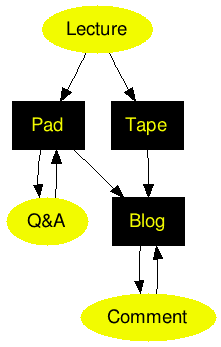Lectures Format
Contents
Intention
The lectures series of the open source domain are meant to put students in contact with both practitioners, to inform and inspire their own practice, and with theoreticians, so as to ground their research within an existing body of reflections common to data design, digital craft and open design.
An important aspect of the open source domain lectures is a desire to go beyond the traditional separation between the lecturer and their audience. In this conservative classroom set-up, students are often given a passive role. In order to trigger a more active engagement with the topics discussed during these lectures, as well as with the guest lecturers themselves and the open source domain community as a whole, students will be using novel collaborative note taking web applications and form small respondent groups. The purpose of this system is to put the students in a situation of focus where the information received is more likely to be retained and comprehended through the process of a self-conscious collaborative writing. In a second stage, the student groups are required to analyse their notes in order to form a question for the guest lecturers. The latter stage is two-fold: it gives an opportunity for the lecturers to correct any misunderstanding on the student side; it opens a possibility to explore further a specific interest of the students.
Finally, a group of students, for each specialisation, will be selected and asked to write a short 500 words reflective article, that will be published on the open source domain blog, along with the notes taken by all the students with a video recording of the lecture. Once published, the guest lecturers will be asked one last time to respond to the students by the means of a comment on the posted article. This final step is used to train the students in critical thinking, synthesis, and written communication skills with a "real-life" situation provided by the public blog of the open source domain. It will also be used to make them reflect upon the issue of authorship, credit and original research as they will be working using notes taken by their fellow students. Last but not least the blog thus populated further after every lecture, will provide a living archive and essential resource both for students and an online audience interested in what is being researched and discussed at the Willem de Kooning Academie.
Workflow
During the lecture
Lecture
Duration: 30 minutes
Ideally, two guests, a practitioner and a theoretician are invited to present their work and research. They are both asked to prepare lightening talks of 10-15 minutes. This format is not rigid and can evolve depending on the topic covered. For instance in some case, the practical work can be used as a case study and the other guest may respond to the presented work.
Meanwhile students, in groups of 5, will be taking notes on the open source domain etherpad.
The lecture is recorded digitally (audio + video).
Preparing questions
Duration: 30 minutes
The students, still in groups of 5, use their note to isolate topics, issues, questions that related to their specialisation and that they would like to get feedback from the guests. At the end of the round one question must be formulated and added to the pad.
Meanwhile, the recorded video is encoded to several web friendly formats.
Q&A
Duration: 60 minutes
Each groups quickly sum-up their notes and ask the question to the guests. The guests will have roughly 5 to 10 minutes to respond to each question/issues. The students group which is asking the question is also responsible to write down the guest's response on their pad. The host needs to moderate the process to keep everything on track and on time.
Meanwhile the video is uploaded to archive.org under a free culture license and embedded in a blog post, immediately posted on the open source domain blog.
After the lecture
Assignment
At the end of the lecture, the host forms three new groups of students, one from each specialisation, and gives them the task to turn all the notes taken from their fellow students of the same specialisation, into a coherent reflective report of 500 words.
Publication and final feedback
Upon reception of the article, the host will post the article on the open source domain blog and will ask the guests to comment one last time on the post, literally using the blog's comment system, as a mean to provide one final note or postscript to the whole process, both closing and opening up the topic to new interpretation.
Integrate following in text
Question for lecturer studium generale:
- prepare; lecture
- deliver one week before lecture;
- text of academic work related to lecture
- art/design project (best practice) related to lecture
- news article related to lecture
- After 3 weeks read and comment on approxiametely 8 reviews of students
